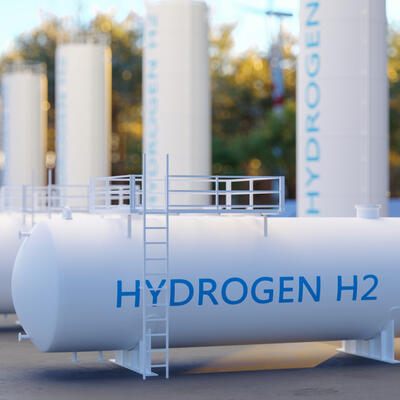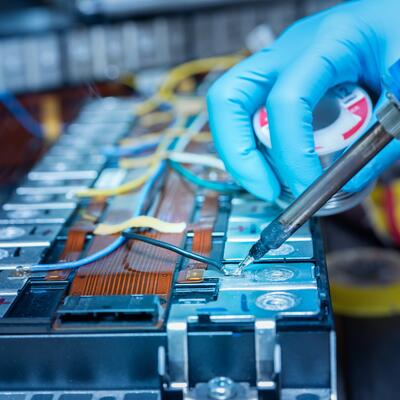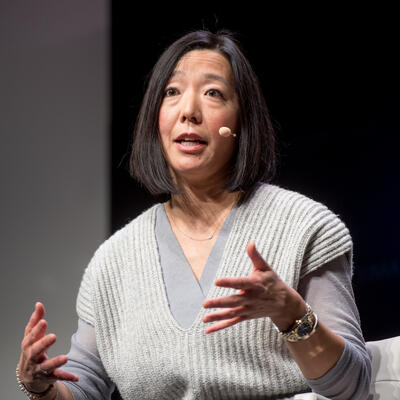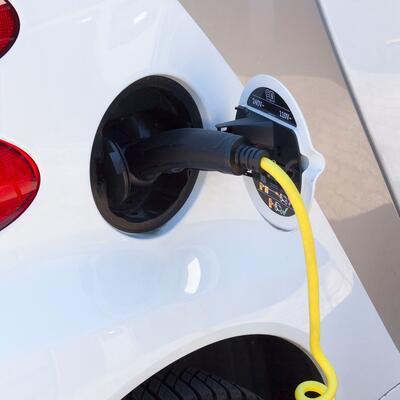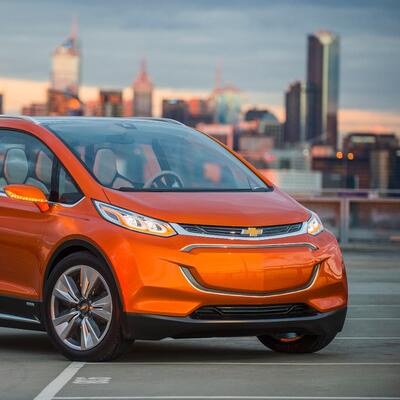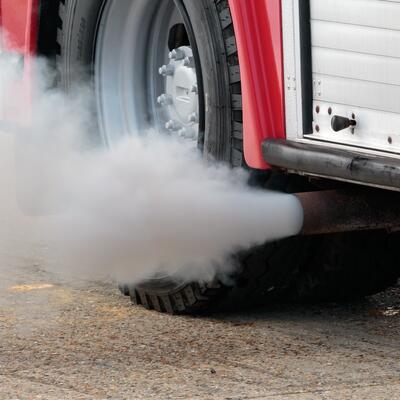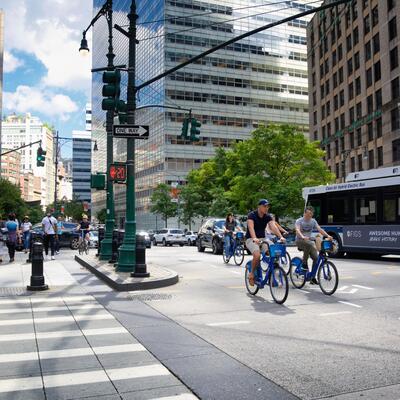
The Road to Zero Emission Trucking
Guests

Ray Minjares

Mike Roeth

Chris Shimoda

Adam Browning
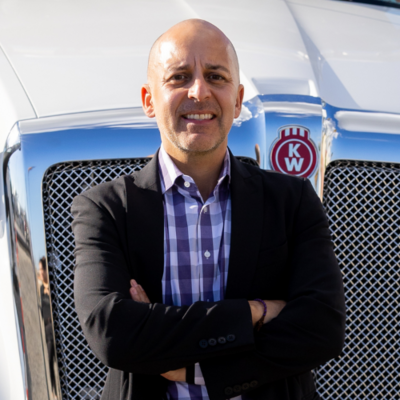
Rudy Diaz
Summary
As the build out of infrastructure for electric passenger vehicles gets underway, another segment of transportation is just starting down the road to electrification: heavy duty trucks. This is a huge category–including everything from the mail and garbage trucks to bus fleets and e-commerce delivery vans that move through town on a daily basis, all the way up to long-haul semis that criss-cross the country. It’s one of the hard to decarbonize parts of our economy. Right now, nearly all long-haul trucks run on fossil fuels.
“The modern supply chain is basically 80% trucks delivering goods,” says Chris Shimoda, Senior Vice President of the California Trucking Association. If we continue with business as usual, freight will become the highest-emitting part of the transportation sector by 2050.
Seven states, led by California, have mandated that an increasing number of zero-emission trucks be sold between now and 2035. That’s going to be a big lift. Adam Browning, Executive Vice President of Forum Mobility, says, “There are about 33,000 class A trucks operating in California’s ports today. If you're to convert all of those to electric, we’d need on the order of 2000 acres worth of charging – about 2.5 gigawatts worth of charging equipment.”
Trucking is a vast and complex segment of the economy, with many different classes of trucks fulfilling different needs for just about every type of business. That makes decarbonizing the sector complex as well. The easiest place to start would be short-haul trucking and drayage, which refers to the movement of containers by trucks in and out of ports to warehouses and nearby distribution centers.
Shorter, predictable routes make it easier to anticipate the energy needs of the trucks and allow for charging infrastructure to be built where it can be most efficient – like truck destinations or where the truck is stored overnight.
For short-haul or drayage trucks, the biggest obstacles to ownership are the upfront cost and the charging infrastructure. Battery electric trucks can cost up to twice as much as diesel trucks, even if reduced fuel and maintenance costs make them more economical in the long run. Some companies are experimenting with new ownership models for these trucks, like Forum Mobility, who is building electric charging hubs for heavy duty trucks and offers the trucks and the charging to owner operators for one monthly price.
“Our business model is to help build the infrastructure to enable this transition to zero emission trucks for the drayage industry,” says Forum Mobility Vice President Adam Browning.
It’s hard to understate just how big these changes will be for the trucking industry, says. Chris Shimoda. "100%. It is a revolution. This is going to transform the supply chain as we know it. You simply cannot sit on the sidelines and do nothing."
This episode features a freelance piece from Emily Cohen in Wyoming on trucker views on EVs.
Episode Highlights
2:41 Ray Minjares on the current state of zero emission trucking
7:07 Ray Minjares on the buildout of charging infrastructure
14:43 Chris Shimoda on the trucking landscape
21:33 Mike Roeth on the first mover advantage
26:10 Mike Roeth on his first time driving and electric big rig
33:20 Freelance piece from Emily Cohen in Wyoming on trucker views on EVs
38:28 Adam Browning on alternative truck ownership models to speed up the transition
41:52 Adam Browning on what makes the transition difficult and how to address it
45:07 Ray Diaz on naming his company after his favorite english teacher
47:22 Ray Diaz on his experience leasing trucks
Resources From This Episode (4)
Full Transcript
Note: Transcripts are generated using a combination of automated software and human transcribers and may contain errors. Please check the actual audio before quoting it.
Greg Dalton: This is Climate One. I’m Greg Dalton.
Ariana Brocious: And I’m Ariana Brocious.
Greg Dalton: As the build out of infrastructure for electric passenger vehicles gets underway, another segment of transportation is just starting down the road to electrification: heavy duty trucks.
Ariana Brocious: Right now nearly all of those trucks run on fossil fuels. And if we continue with business as usual, by 2050 freight will become the highest-emitting part of transportation, which itself is a top source of greenhouse gasses.
Chris Shimoda: The modern supply chain is basically 80% trucks delivering goods.
Greg Dalton: That’s Chris Shimoda [Shi-mode-duh], Senior Vice President of the California Trucking Association. His members own and operate commercial trucks and are backing the move away from highly polluting diesel that has been the industry standard for decades.
Ariana Brocious: In order to cut diesel emissions, seven states, led by California, have mandated that an increasing number of zero emission trucks be sold between now and 2035.
Greg Dalton: The two leading technologies to decarbonize trucking are battery electric and hydrogen fuel cells. Either one would be a big improvement for the climate, and drivers.
Mike Roeth: Drivers talk about how they're less tired, they don't feel as fatigued. I think electric trucks will be the biggest driver attraction and retention technology or thing that we’ll ever see.
Greg Dalton: That’s Mike Roeth [Row-th] (rhymes with both), Executive Director of the North American Council for Freight Efficiency.
Ariana Brocious: As of today it’s looking like battery electric trucks are closer to mass adoption, which means we’re going to have to ramp up the charging infrastructure fast to meet California’s ambitious goals.
Greg Dalton: And that’s going to be a massive project. Right now, there isn’t really a public charging network for Heavy Duty electric trucks the way there is for EVs.
Ariana Brocious: Plus, recharging a big rig takes a LOT more power than a passenger car. So the utilities and grid operators need to get involved as well. To get a clearer picture of where zero emission trucks stand today, and what it will take to cut emissions in this sector, I spoke with Ray Minjares, Heavy-Duty Vehicles Program Director at the International Council on Clean Transportation.
Ray Minjares: We’re starting to see a lot of attention and progress with respect to truck electrification. First, I think it's important to distinguish between trucks that are driving relatively short distances, such as, say 200 miles and then long-haul trucks. So when we look at these short-haul trucks the solutions are very clear and already being rapidly deployed. And that’s because these are gonna be powered by batteries. And these are vehicles that take advantage of the fact that they have dedicated trucking depots where they’re parking overnight. They have sufficient time to charge fully and those batteries are not so big and heavy that they impede on that vehicle's ability to deliver on its various routes. And I would include in that bus fleets. I would also include refuse trucks and urban delivery vehicles. You can think of some of these Amazon Rivian vans as an example.
Ariana Brocious: The two leading options for decarbonizing heavy duty trucking are electric batteries and hydrogen fuel cells. But in spite of some of its advantages like quick refueling, Minjares says the market is moving away from hydrogen for a whole bunch of reasons, including cost and the growing industry of battery swapping.
Ray Minjares: The downside with hydrogen is that even though you have this ability to carry more weight and fuel faster. It is a more expensive fuel and it is a far less energy-efficient vehicle. So the hydrogen tractor is really not getting you anymore mileage per diesel gallon equivalent compared to a diesel truck today. And that energy cost, especially if we’re talking about green hydrogen is such that it will never allow a hydrogen tractor to reach parity with diesel now or for the foreseeable future. And we've looked at it to 2040.
Ariana Brocious: By contrast, Minjares says with lower energy and maintenance costs, there are already starting to be economic advantages to switching from diesel to battery electric trucks.
Ray Minjares: For those real urban use cases that are depot-based staying within 200 miles I think the total cost of ownership for a number of these is already there. Meaning that parity exists with diesel and it's worth the investment to switch away from diesel. It's our view at the ICCT that we could see 100% of our buses going electric, meaning the sales of buses going electric by the end of this decade. And I think similar vehicle types have the possibility. And I would include drayage in that as well.
Ariana Brocious: Drayage refers to the movement of containers by trucks in and out of ports to warehouses and nearby distribution centers. In the trucking business, the trucks themselves are major investments, and while zero-emission rigs cost significantly more than their diesel counterparts, Minjares thinks they’re investments that will pay off.
Ray Minjares: What’s different from the passenger vehicle segment is that trucks are an asset to the business. And so whatever that upfront cost is so long as it's making a return on that investment over time. It's worth that investment.
Ariana Brocious: And the efficiency of battery electric trucks is a big factor in their long term affordability for short, regular trips. But for long haul trucks, which travel 300 to 500 miles or more and can spend 20 hours a day on the road, the path to decarbonization isn't as clear.
Ray Minjares: These vehicles are not returning to a common point of departure. So that means that they’re gonna have to find a place to stop along the way. The other issue is that these vehicles need to have enough energy on board in order to travel at full range. So the major challenges that we see facing the long-haul trucking sector have to do with land literally space to park the truck and also the energy storage on the vehicle and specifically the ability of batteries to store enough power.
Ariana Brocious: Minjares says in order to make this work we need to build electric truck depots with sufficient charging power along major interstate corridors.
Ray Minjares: So in order for these investments in let's say battery electric long-haul tractor to pay off this is going to require megawatt charging. Which is obviously orders of magnitude more power than what you would see in your typical home. So this is the difference between long-haul trucking and passenger cars. We’re just talking about bigger batteries and we’re talking about much faster charging. And as a consequence, much bigger investments in that infrastructure.
Ariana Brocious: Current long-haul truckers are used to diesel fueling, which takes minutes. In order to compete with that and supply battery trucks with a whole lot of power very quickly, the grid will have to undergo changes too.
Ray Minjares: There will need to be investments in especially the distribution grid capacity of our power infrastructure. This means investments in substations transformers feeder lines. So look out your window and if there's a utility pole there that will likely need some investment if it's also heading to a local depot. These are the types of investments that I think are going to be the most important for electrifying the trucking sector. Already we are seeing billions of dollars of investment going into this. And again, this is ahead of any national policy that's requiring this. And we’re seeing that investment because the business cases there. And so I can give you a couple of examples. Terawatt Infrastructure is a company that is planning a long-haul charging corridor from Long Beach to El Paso 800 miles with electric depot stops every 150 miles. Tesla who has the Tesla Semi has been working with state officials in California and in Texas to build an 1800-mile electric truck highway from their production facility in Fremont, California all the way to Laredo, Texas, which I expect will connect to their production facility in Mexico. So these are investments that do reflect billions of dollars today that are planning for the future. And that's the scale of investment and the pace investment that we really need to see right now.
Ariana Brocious: New trucks and new infrastructure aren't cheap, but Minjares says businesses large and small are putting money into this transition.
Ray Minjares: Today the owners of trucking fleets include large corporate companies like Penske and Ryder and we also have major retailers like Walmart and IKEA and others. Some of these own trucks outright some of them are contracting for trucks. We’re seeing companies like Walmart commit themselves to hundred percent zero carbon trucking fleet by 2040.Whether you are one of these large corporate fleets like Walmart or a small business that’s operating 1 to 5 trucks. There is going to be the strong business case in front of you to be investing in this cheaper trucking solution, which is the zero emission battery electric solution. So if you’re a company like Walmart, you will be investing with your private capital with a little bit of help from the government, whether that's the federal government through the Inflation Reduction Act which provides incentives for the purchase of the vehicle as well as for the infrastructure. But a company like Walmart will be investing in its bottom line and it will realize economic returns on that.
Ariana Brocious: For smaller trucking companies or businesses, Minjares says there’s innovation happening around providing leased trucks, charging and parking, like Forum Mobility, who we’ll hear from later in the show. According to estimates from the California Energy Commission, we’d need to install 52 chargers per day every day for seven years to meet state demand for medium-to-heavy duty trucks.. It's going to take a massive coordinated effort to build out that charging network. But Minjares isn’t daunted.
Ray Minjares: It's not whether or not we have the resources. It's not a technology issue from my perspective, I think we know what is the most cost-effective solution and what will deliver the greatest health benefits. The real question is do we have enough people in the right places at the right time to actually design and construct all of this infrastructure. So for those who are really trying to understand the job implications of this. I would say that this is a huge opportunity to grow our economy and transition away from fossil fuels towards a clean energy future. But it does mean that we cannot take 5 to 10 years to plan for it. This is happening now. And so my message to those who have the ability to build this charging infrastructure is do not wait for this. This is already happening and you need to start putting plans in place now to build it.
Greg Dalton: On Climate One we are talking about decarbonizing heavy duty trucking. If you missed a previous episode, or want to hear more of Climate One’s empowering conversations, subscribe to our podcast wherever you get your pods.
Please help us get people talking more about climate by giving us a rating or review. You can do it right now on your device. You can also help by sending a link to this episode to a friend. On our new website you can create and share playlists focused on topics including food, energy, EVs, activism.
Coming up, how difficult will it be to transition away from diesel trucks by 2035?
Chris Shimoda: The reality is these are going to be, I think, revolutionary changes is the right word. I mean it is going to involve Manhattan project style efforts to get the charging infrastructure just alone in place.
Greg Dalton: That’s up next, when Climate One continues.
This is Climate One. I’m Greg Dalton.
Ariana Brocious: And I’m Ariana Brocious
Trucking is a vast and complex segment of the economy, with many different classes of trucks fulfilling different needs for just about every type of business. So given how complex the sector is, what does the big picture look like when it comes to decarbonizing trucking?
Greg Dalton: I talked with Mike Roeth [Row-th] (rhymes with both), Executive Director of the North American Council for Freight Efficiency, or NACFE [NAK-fuh]. As part of its mission to improve trucking efficiency, that group stages annual demonstrations called Run on Less. In 2021 they introduced Run on Less - Electric, which features various trucks, and charging systems to demonstrate the technology and learn from the experience.
Joining our conversation is Chris Shimoda, Senior Vice President of the California Trucking Association, one of the largest groups of truck owners and drivers in the state. He gave us an overview of the commercial truck landscape.
Chris Shimoda: It's not homogenous. You say “trucking" could mean any dozens of different business models parts of the industry that they service. And so while there are some, you know, brand-name large companies in trucking it's really in industry that's dominated by small business mom-and-pop type operations. It's a majority minority workforce here in California. And the type of operations that they serve, I mean it’s so diverse it’s everything from construction to agriculture, fuel delivery, food distribution. The examples I've been using with my Gen Z folks is the Taylor Swift concert I've seen somewhere between 50 and 90 trucks work in, you know, the riggings and _____ getting them from town to town. So, you know, nearly every facet of modern life is touched in some way by trucking. And, you know, beyond that just us as everyday citizens have come to expect that goods and services are going to be available more or less on-demand at a cheap price. the modern supply chain is basically 80% trucks delivering goods. And so it's a tough question to give a single answer to because every trucker does face very unique challenges depending on their operations. But, But I'd say that there still may be not a full understanding of the challenges that truckers face to really provide the levels of service that societies come to expect, you know, on the face of just simple things like not having anywhere to park the truck. If you go up and down any interstate around the country, you’ll probably see truckers taking their mandated rest breaks on side of hi-ways and that's because there is just simply is not enough just basic areas to park the truck overnight. Here in the state of California you'll hear a lot about over burdensome regulations, you know, not the least of which is the upcoming California Resources Board Advanced Clean Fleets Regulation. That's really a prime example of I think something that is gonna have a really big impact on the day-to-day operations in life of truckers.
Greg Dalton: Well, let's pick up on that, Mike, I wanna get you in here there is this California Advanced Clean Fleets Regulation will require all truck serving the state’s ports known as drayage trucks to start transitioning to zero emission technology beginning next year, with full implementation by 2035. That's over 33,000 trucks that will need to be replaced in the next 12 years part of the reason we’re talking about this now. What do you think Mike about that regulation and how that will affect this migration we need to make towards lower emissions trucking?
Mike Roeth: You know we've been working on alternatives to diesel for decades. And the reason is that diesel has been an incredibly good fuel. Diesel engines are sort of an extremely well high torque they’re great in moving goods they’re great at doing the tough job at trucking. but diesel as you know is known to give us climate effects and we’ve come a long way I mean the NOx particulate matter in these trucks as well as the carbon emissions of these trucks. The fuel economy has gotten much, much better over the last couple of decades but we’re still not there. And the drive of society to be more sustainable in all aspects but also around moving goods is definitely upon us. there’s kind of three ways to go about this, all of which the industry is working on. One is burn less diesel in moving the goods. So be more efficient with your tractor-trailers. You know be smarter about how we drive them. Drive slower if we can. Work on technologies like aerodynamics and others. The second is get to zero emissions where we can so the rule is looking to turn the California fleet over from diesel to zero emission. And right now, there's two ways to do that. There's battery electric trucks and there’s hydrogen fuel cell electric trucks.
So some duty cycles and some operations in trucking are very good for battery electric. So think about the vans that are bringing your ecommerce packages to your homes. Now that’s very small trucks or very urban trucks like delivery vehicles box trucks, maybe even you know some drayage and some other short-haul heavy truckers where, you know, beverage is a good example they do, 60, 70, 80 miles only a day. They are at the stores bringing the beverages and food in. And so there are good applications for electric. Now there’s a lot of other work to do with electric. But those two are two of the three. And then the third one is things like renewable natural gas renewable diesel. There are a number of fuels and technologies including hybrids that’s happening a bit in trucks you know, diesel and diesel engines were the one answer for us. We don't have one answer going forward in the future. And that means a lot of change for truckers and the whole entire supply chain of trucking.
Greg Dalton: So Chris Shimoda, your members are owners and operators of trucks. What's your view on California saying trucks must be zero emission by 2035?
Chris Shimoda: I don't think you're going to hear a single member of our organization say that they oppose zero emissions. And I agree with Mike's assessment that there is no single solution unfortunately at this point in time to replace every type of trucking. And so there are specific use cases and just to simplify it is if you have a smaller truck that returns to a central location every night and you've got 8 to 10 hours to charge ideally overnight that is a use case that I think most people in the industry would say, irrespective of regulations because of the advantages of battery electric technology and that sort application that that is gonna happen in the near-term.
Greg Dalton: If I could pick up there, Chris, for a minute, like you said battery electric trucks are just better in some cases, why and where?
Chris Shimoda: So the advantages the battery electric vehicles are gonna have it’s really in operations and maintenance. Fewer components you can think of things like you know either spark plugs or oil changes, in the future as these things actually get deployed in large numbers there’s a presumption that the operations and maintenance is gonna be lower moving forward. Now, there are some complications there where I'm sure we’re gonna be talking about infrastructure here in a bit. Electricity in the state of California is already pretty pricey compared to the rest of the country. And it's gonna be certainly I’ll say in the tens of billions if not more to upgrade the infrastructure to accommodate electric truck charging. That’s gonna be some of the tension on the economics. But in an ideal world in certain applications you are gonna see cost savings but again I need to stress it’s a very specific types of uses where this is gonna manifest.
Greg Dalton: Mike, do you have a thought there on the economics of this transition? Clearly, fossil fuel prices fluctuate a lot. Electricity prices less so because they’re regulated. How will the transition to zero emission trucks affect the economics of the business?
Mike Roeth: Well, we're in a real marathon here, not a sprint. So I’ve been in the trucking industry 37 years and a long-term plan used to be two years. I mean we’ve got to move the goods every day, every hour, and in the pressures on it to move. Now, we’re really looking at decades, you know, 10, 20 years where these companies whether you’re a carrier whether you’re a truck builder or parts supplier, a dealer. You have to really be looking at a much longer horizon. So, given that I think, you know, we don't need to have all of this figured out right now. The rules they do have a phase in a timeline I mean this is like not like zero and then a hundred percent in 2035. And the benefit of the disparate types of trucking that we were talking about a bit earlier is actually advantageous in this transformation in my eyes. Because what it means is there are certain parts of the market that can be more ready for battery electric and hydrogen fuel cell when they are ready. And then will learn from that we will understand from a 75-mile heavy-duty beverage tractor and the depots that are charging 50, 75, 100 of those. We’ll learn from those that make sense now or soon in order for the technology to work better in five years for this in 10 years for a longer distance, and so forth. And we’re just getting started, I mean we do run on less electric. We did one in 2021 we’re doing now one in 2023. Basically, the range of the heavy truckers is doubled in two years. They've added batteries, but they’ve also improved the efficiency of the trucks. Charging is gone from you know 20, 30 kW to 150, 180 in some cases, 350 kW and 750 for the Tesla Semi. So my point is that this technology is still young and will get better and better. And while we work on the applications and the parts of the market that it economically makes sense now or soon until we move in later.
Greg Dalton: Mike, what’s incentivizing fleet operators to move as fast as they can. And is there a first mover advantage?
Mike Roeth: Yeah, very good question. And I would say that first of all we’re in a like a win versus an F. I mean this transformation is started there are some questions around for the longer haul return to base or the long-haul disparate route, you know, truck stop, sleeper trucks running all over the country. There are similar questions about whether that’s hydrogen fuel cell whether that’s drop in renewable fuels and so forth. So there are still a lot of questions in the higher-end but, you know, it's happening. And so the first movers are, you know, I’ve kind of come to the conclusion that you can't really sit and do nothing and just let this work its way out. At a minimum, you need to be going reading information going to conferences talking to your peers in whatever part of trucking you’re in because it is happening. And it's enough of a transformation and I have been really critical of my own thinking here to make sure that this is a big enough transformation or this sort of like an emerging thing, you know, that sort of an evolution, not a revolution. I think this is pretty big. I mean this is like when we went from horse and buggies to engines. So it is big. So there is an advantage to be a first mover. It's expensive. There's some bleeding edge. I mentioned more or less we have ten depots right now that we’re studying, they’re definitely early movers, eight of which are in Chris' state. And they are doing it because they expected to be in the future. There are some incentives that California and other places are helping to get the infrastructure in place and the vehicles in place. But those first mover believe that they really need to not just watch but participate early to learn and figure this out as they move into this sort of that, you know, two- or three-year plan versus a 20-year plan. They know they better get started or they will be behind. I kind of think the idea of waiting and be in a fast follower or the myth of being a fast follower is a recipe for real problems in the industry.
Greg Dalton: Chris, do you agree with Mike that this is a revolution moving away from fossil fuels to electric heavy-duty trucking? And whose best position for this transition and whose kind of at risk?
Chris Shimoda: Oh, 100%. It is a revolution. I mean this is going to transform the supply chain as we know it. I'd agree with Mike in saying that you simply cannot sit on the sidelines and do nothing. The advice that we’re providing to fleets you know, looking at these rules and I will push back a bit in saying that the ramp-up unfortunately is not I think is reasonable as we would like it to be. There really is a timeline problem. I point to the fact that we're expecting roughly 2000 drayage trucks in Southern California to age out as early as 2025, which would necessitate it's basically the electrical demand of a small city being installed to meet just that 2000 truck fleet. Those are the sorts of things that when you look at the lead times involved in getting some of this stuff in place so the charging specifically, this is not as simple as going to your truck dealership ordering a truck taking it home and running it. There is a pretty extensive process to get the size of charging that Mike was talking about the 150 kW, 350 kW up to a megawatt speed eventually. That involves a pretty extensive process with your local utility and that is really what we’re telling fleets is you need to start understanding what technology is out there on the vehicle side. You also need to understand what charging infrastructure entails. This is not as simple as calling up the utility to come out the next day and install your charger. For larger type installations or where you are co-located on a specific circuit that is gonna require the utility to do significant system upgrades that can be a 7+ year process. And the just charging infrastructure installation itself on a large scale is a major capital infrastructure project. You’re gonna have multiple construction contractors, electricians, the utility. There’s gonna be a list of page and a half long of people involved in that process and it will take years and many cases. So we’re encouraging folks to really get familiar with what actually deploying this technology means within their fleets. There are so many considerations you own your land or you leasing it from a landlord. What is the length to your lease you actually have to be in that property long enough to execute a contract with the utility for charging? That's just the simple fact. We have folks that are parking trucks to customers facilities smaller type operators that are bringing trucks on the apartment complexes at night. And so where is the model that is gonna be successful for this just wide variety of range. I mean it’s not unlike the light-duty EV use case for folks who are in like apartment complexes or places that they don't own and a lot of the challenges are a little bit similar. Just that the charging peak demands are like nothing that we’ve seen on the passenger EV side there’s gonna be significant utility impact.
Greg Dalton: Mike, when you first got behind the wheel of an electric big rig yourself what was like what was your reaction?
Mike Roeth: Oh my gosh, they are wonderful pieces of equipment for a couple of reasons. One, they're really simple. I talked about diesel a lot, you know, but diesel is become really complex and the engine itself we've got after treatment, you know, tens of thousand dollars of equipment on these trucks to clean up the exhaust. We've got all kinds of different technologies around sustainability or just burning less fuel and so forth. So they become really complex. The beauty of the battery electrics truck is where it works is it’s really simple. You got batteries, you got electronics, you got motors. And you got, you know, some systems around it like electric air conditioning and so forth. But much fewer parts and everything. So that's where it starts is that it's a simple or a truck. But what then happens is it's just very easy to drive regenerative braking is very intuitive to the drivers. And we’ve now work with 40 electric truck drivers over the last couple years. They all love the trucks. We have automatic transmissions in heavy trucks, but it's really a bit of a myth where it's a robot shift and a mechanical manual transmission. And so the automated manuals of today still, whenever they shift they go all the way back to very low RPM, the whole cab shakes takes a long time to get from the dock out to the freeway it’s demanding. I mean in a couple of the videos that we just produced on Run On Less the drivers talk about how they're less tired they don't feel as fatigued, let alone the exhaust and the fuel that their close reek of and so forth. think electric trucks will be the biggest driver attraction and retention technology or thing that we’ll ever see.
Greg Dalton: Chris, do you agree with Mike that electric trucks will help driver recruitment and retention
Chris Shimoda: You know, at this point in time it really just boils down to we've got I think the last time I checked around 500 of these trucks deployed even in the state of California, which is probably the leader if not globally certainly nationwide due to our policies and our incentives. And so, you know, We have so little experience. But I would agree with the benefits to the driving experience itself are gonna be clear, just because of you know the reduce noise reduce exposure to exhaust, you know, everything that Mike talked about. Now one of the complicating factors right now really has to do with the charging models. So for instance you know we just talked about where this technology works. If you can, you know, go home at night and park the truck get in your car and go home while it charges, that's wonderful. We do have a regulation on the books today that doesn't exactly work that way. We are gonna have drivers who nearly on a daily basis imagine this you have a 600-kWh battery which is close to where a lot of the class A big rigs are coming in. And 150 kW charger where some of the battery management systems will not allow charging beyond that speed. So you’ve got roughly 4 hours to wait there to charge if you’re at a completely discharged state. Imagine if when you got in your car and headed to the service station put in the nozzle it took four hours to fill up your car every day. That is, you know, some of what we don't talk about that we just simply have not perfected the technology. We don't have widely available megawatt speed for faster charging which will reduce those charging times. We are really going into this, you know, wide deployment in the state of California with luscious say less than ideal technology and infrastructure at this point in time. But once we get those issues figured out you know in an ideal world; the driver experience is gonna be much more positive.
Greg Dalton: Right. And that's certainly been true for me as an EV owner and driver for more than a decade. Now when I go to a supercharger for a Tesla, I get sometimes 500 miles of range in the beginning for an hour of charging. So that charging has advanced and gotten faster certainly quite recently. We mentioned batteries there are kind of range constraints battery electric vehicles weigh around 6000 pounds more than diesel. Federal law limits loaded truck to 80,000 pounds you get a little more of that if you're electric. But still about 5% cut in revenue or profit per trip. Mike, you said this weight issue is overblown because battery sometimes get hit for, oh, they’re too heavy for big trucks. Why do you think it's overblown?
Mike Roeth: Well, first of all, not every shipment is at 82,000 pounds for electric or 80,000 pounds for diesel. So as these trucks are heavier, they do cause problems when you go to move the freight and maybe you have to have, you know, if you are grossing out on those loads it was an electric truck you have to haul less freight so you need more trucks. Fact of the matter though is very few trucks do gross out and a lot of them are well under the limit. So in those cases, you know some additional weight can be handled. It's a matter of really understanding where and when you have that problem or where you don't have that problem. A lot of goods are lighter and you just can't pack the trailer full enough or our demands for goods require that the shipments be less. You know, maybe you need to get the goods and the system set up for freight to be moved in a certain timeframe where you have to take half a load versus a full load. And in those cases, then that weight just doesn't become that big of consideration. Butto Chris point we are so new here. We need to get more product out we need to understand what all these aspects are of different models different freight movement what are the weights of these trucks really. It’s
Greg Dalton: early days. Quickly, each of you. How confident are you that the industry can make a complete shift to zero emission trucking and the time required by California and the 15 other states that are lining up with California? Chris, how about you first.
Chris Shimoda: So analysis from the state would suggest that we need if we’re gonna get our 2035 goal for instance, we need to be building about 300 DC fast chargers getting them installed every week in just in the state of California alone. And as context currently in the state we've got 9000 DC fast chargers throughout the entire state. So we would need to build the entire states quantity of chargers basically in the first 30 weeks of the program. So, you know, if you're talking near-term, I use the example of the ports in Southern California alone. We need to get that you know city -sized charging infrastructure in place by 2025. And just by the nature of the utility process where some of these major upgrades can take you know in the best case 18 months in the worst-case 7+ years. The likelihood that we’re gonna have all of that in place and it just depends on what interim goal you're looking at. We are going to run into problems meeting the state's timeline. It’s again it’s not a matter of that the transition is happening or that there's any opposition to it. The just the reality is these are going to be I think revolutionary changes is the right word. I mean it is going to involve I’ve heard other people saying Manhattan projects style. Efforts to get the charging infrastructure just alone in place.
Greg Dalton: Mike, I hear we need speed and scale faster.
Mike Roeth: Yeah, I think there's several pinch points. And then there's also a lot of this can happen and will happen, but there's some pinch points. I think battery supply. I think you know we’re electrifying nearly everything in humankind it seems like. So, you know, not only do we need batteries for the vehicles we need batteries for backup power and storage when say wind doesn’t blowing and the sun is not shining. So we need batteries I think that very well could be a pinch point. I think the charging infrastructure just the project management of getting these chargers in the ground. The third one is the grid And then I think the last one is kind of maybe an odd one, but it’s just how do we go from one fuel in all of these trucks to many and how do we do that effectively. So how do we help each fleet out there. And Chris is right I mean there's hundreds of thousands of fleets out there. Everything from people moving lawnmowers and doing landscaping all the way up to mining trucks and all that. But how do we effectively really make the right decisions about which one should be batteries, which ones helping customers get the right solution for their needs. Batteries, renewable diesel, renewable natural gas. Battery electric hydrogen fuel cells. And this time we didn’t even talk about burning hydrogen in an engine, which is a very interesting other technology. So how do we make all those decisions that’s sort of another pinch point that I see. If we do that well this will go easier if we don't do that well it'll be really problematic.
Greg Dalton: Mike Roeth is Executive Director of the North American Council for Freight Efficiency. And Chris Shimoda, Senior Vice President of the California Trucking Association. Thank you both for coming on Climate One today to talk about trucking.
Mike Roeth: Thank you.
Chris Shimoda: It’s been fun.
Greg Dalton: I have to say, it’s exciting to hear one of the largest associations of heavy duty truck owners and drivers talking about the move from oil to batteries as a revolution. That kind of surprised me.
Ariana Brocious: good to hear industry getting on board with decarbonization – not fighting it, though they did cut a deal with
Greg Dalton: They also see a role for hydrogen in certain heavy duty vehicles. Forklifts are one example.
Meanwhile, oil companies and Toyota are still trying to push Hydrogen for passenger vehicles, but the market has spoken, and it's clear batteries have won in the marketplace.
Ariana Brocious: But for long-haul trucking, implementation of battery electric or hydrogen fuel cell vehicles and infrastructure remains a challenge. Especially in places like Wyoming – where the distances between towns can be dozens of miles. Climate One correspondent Emily Cohen spoke with truckers in the Cowboy State about their thoughts on zero emission machines.
Emily Cohen: It’s a summer day at the KJ’s gas station in Alpine, Wyoming, 40 miles south of Jackson Hole. A slow but steady stream of truckers and road-trippers fill up their tanks and stretch their legs.
Eric Sollender, a FedEx driver who drives upwards of 200 miles a day in a three-axle straight truck, was open to driving an electric vehicle.
Eric Sollender: Oh, as long as it was reliable, it wouldn't make any difference to me.
Emily Cohen: Reliability is a top priority in this northwest corner of Wyoming. Winter temperatures often dip into the single digits and snow can pile up on steep mountain roads. Cold temperatures can sap EV range – just as fuel economy drops for gas-powered cars.
Javier Gonzales: Electric vehicles to me are a joke.
Emily Cohen: Javier Gonzales, a trucker from nearby Idaho, prefers to stick to what he knows.
Javier Gonzales: I'm a gas-powered person. I've built cars my entire life. People think electric vehicles are the way to go. But actually, they cost more money to run than a gas-powered vehicle. I mean, even to make the batteries costs thousands of thousands of dollars. And then if the batteries go out, it costs thousands, thousands dollars to replace them.
Emily Cohen: While EVs may cost more at the outset, over time they’re more economical because of lower maintenance and fuel costs. But whether they were for or against the technology, everyone I spoke to agreed recharging infrastructure is a major obstacle. Here’s Darren, a trucker from Colorado who only gave his first name:
Darren: We don't have enough charging stations in the United States, especially for the trucks. It's not even enough for the cars right now. So that's the biggest thing. I mean, if they can get it at every truck stop, it wouldn't be a problem. But, you know, how much money would that cost?
Emily Cohen: The 2021 bipartisan infrastructure law allotted $7.5 billion dollars for states to come up with plans for how to address EV charging – with guidelines to build stations every 50 miles along interstates.
But in rural states, like Wyoming, the 50-mile rule can be a challenge. The few towns along Interstate 80 are about 100 miles apart. That distance is a legacy of another form of transportation – the railroad. 100 or so miles is how far trains could travel in the late 19th century before crews needed rest and locomotives needed maintenance.
Ray Barton drives coast to coast hauling whatever will pay the bills, or as he puts it:
Ray Barton: Anything you can strap on a flatbed. I mean, I even hauled marbles.
Emily Cohen: For truckers like Ray, range anxiety with electric vehicles is real.
Ray Barton: Don't want nothing to do with them.
There are no charging stations. I've seen them in California and stuff. They're sitting on the road getting towed. Because they're breaking down and they run out of power. Batteries go dead.
Emily Cohen: Along Wyoming’s lonely highway stretches, it may take a lot to change hearts and minds about electrifying big rigs. At the very least, truckers here need to see evidence that the next recharge is just a few miles away.
For Climate One I’m Emily Cohen.
Greg Dalton: We’re talking about heavy duty trucks driving away from fossil fuels. This is Climate One. Coming up, one company is trying to make electric short haul trucks more affordable for independent owner operators.
Adam Browning: We're building this charging network of charging depots and we will if you have your own truck. If however you don't have your own electric truck or are not able to afford it. We will buy one for you and provide you the truck, plus the charging for one monthly fee.
Greg Dalton: That’s up next, when Climate One continues.
Ariana Brocious: This is Climate One. I’m Ariana Brocious. We don’t always think about how all the things we buy that come from overseas make their way to stores and homes. When ships come into port and drop off shipping containers, those containers then have to get moved from the port to a distribution center. That movement is known as drayage.
Greg Dalton: As we heard earlier in the show, the trucks that take those containers from port to distribution center are perfect vehicles to electrify. That’s because they have predictable routes and dedicated destinations which makes charging much easier and more efficient. Because of this the California Air Resources Board has singled out drayage for accelerated transition to zero emission vehicles.
Ariana Brocious: But two of the biggest obstacles faced by drivers or small companies that want to transition to electric trucks are the charging infrastructure and the price. The upfront cost of a heavy duty electric truck is about twice that of a diesel truck.
I talked with Adam Browning, Executive Vice President of Forum Mobility, about other ownership models that can make switching to electric trucks more affordable.
Adam Browning: So there are about 33,000 big rigs the class A trucks operating in California’s ports today. That is quite a few numbers of trucks. If you're to convert all of those to electric we’d need an enormous amount of infrastructure. We’re looking on the order of 2000 acres worth of charging about 2 1/2 GW worth of charging equipment. And that will just take an enormous amount of capital in order to build.
Ariana Brocious: By 2024 your company hopes to offer 500 chargers across California. The California Energy Commission estimates will need by 2030. So that’s a big scale up and of course your company will not be building all of those. How can we go about making that happen?
Adam Browning: Yeah, it is gonna be an enormous challenge and that figure for 157,000 chargers by 2030 applies across the board to the medium and heavy-duty trucking requirements that the advance clean fleets regulation will require.
Ariana Brocious: So that’s not just drayage that’s --
Adam Browning: That’s not just drayage. School buses and garbage trucks. Amazon delivery vehicles, beer distributors, everything that is currently delivered by a truck. So that is a huge challenge. Like in the next less than 10 years like seven years we’re looking at having to install as a state charging infrastructure at the rates of an average of 53 medium to heavy duty chargers a day every day including Sundays until 2030. Being able to actually do that will require just to a rethinking of a lot of our institutions processes planning around electricity and electric infrastructure going forward. It is an enormous challenge.
Ariana Brocious: So your company from what I understand is building some of these hubs that electric rigs electric trucks can come and recharge overnight. So that would be like a concentrated place where many of them could hook up. When we talk about this number of chargers are, we referring to things like that or it’s more centralized or is that like an individual charger per vehicle type of thing?
Adam Browning: Yeah, that number of 157,000 that refers to the number say dispensers, think about that as just like the number of plugs that we’re going to need. Many chargers have dual dispensers and some have even more than that. But we’re just thinking about when you charge your Bolt at home, you plug it in at the handle that connects to your car we’re gonna need 157,000 of those. So yes, for mobility our business model is to help build the infrastructure to enable this transition to zero emission trucks for the drayage industry. And we believe, you know, success in this will mean clean air for our communities. It'll mean hope in the fight against climate change. And also, importantly if we’re able to do this right it will mean a lower cost per mile for the truckers as well.
Ariana Brocious: So speaking to costs, a battery-powered truck can cost as much as half a million dollars with taxes and fees. And that's about twice or more than twice actually what a diesel truck cost. So explain the truck as a service model and how you help operators overcome that huge price change.
Adam Browning: That's exactly correct. So for people that are looking to make this transition. There are a couple challenges. One is where do you charge it and we’re trying to address this by building the charging, both in and around the ports as well as around the distribution centers. Which are in Oakland that's concentrated out in the Central Valley around Manteca to French Camp to Stockton in ports of Los Angeles and Long Beach, which are the largest port complex in the country that moves the most freight. There’s a ton of stuff in south-central Los Angeles but then also out to the inland Empire. So it's important that you build the entire ecosystem of charging. So both where the truck start and where they end. And so we have sites in the Port of Long Beach inside of the Port of Oakland and we’re building that entire network out to wherever truck needs to go. The other big challenge is the cost of the truck. And the good news here is that the cost of batteries have come down quite a bit and will continue to do so. If you look back 15 years the cost of lithium-ion batteries has come down about 87%. There was a pause and then an uptick during COVID and the supply-chain challenges that we saw globally that faced many industries. we have seen through the investment of the Inflation Reduction Act just an absolutely biblical transformation of the complete battery supply chain manufacturing industry in the United States. And so I'm quite confident that we'll see again a continued really radical reduction in battery prices which is the largest component of the cost in a truck.
So in order to get there though, you know what we need is, you need two things. One is you need some incentives in order to help close that cost gap to stimulate demand to grow scale and bring down costs. And then two, you need a long-term financial perspective. And so many of the people that are in the drayage industry are 87, 80% or so are independent owner operators and they don't have a whole lot of resources. They don't have great financing capability. So we offer two different products. One is that we're building this charging network of charging depots and we will if you have your own truck will offer you access to charging on that network. If however you don't have your own electric truck or are not able to afford it. We will buy one for you and provide you the truck, plus the charging for one monthly fee. With the incentives that are available today, we can provide that at a rate that is roughly equivalent to diesel right now.
Ariana Brocious: So the companies like yours that are buying land near ports and building this infrastructure buying the truck and leasing them to operators have immense financial backing for mobility counts among its vendors a number of venture capital firms Amazon and CBRE which is a multinational real estate company. So in this model as we’ve just been discussing the company will now own the trucks rather than the individuals. How will this concentration of wealth and power affect the drivers who have formerly been owning their own rigs?
Adam Browning: I mean I also just like to offer that we would rather just do the charging. We are only buying the trucks and providing the trucks as it is a necessary service for some. This is how it's going to get them into a new technology that is both costly and that they don't really understand. So if we had our druthers, we would just provide the charging. So, however, we believe that also providing a truck plus charging and providing all the maintenance and taking that operational risk on ourselves is going to be a helpful part of the offerings that will help people that are currently employed using an internal combustion engine truck in order to make the transition to zero emission vehicles.
Ariana Brocious: Do you see a point in which Forum Mobility’s leasing truck leasing will kind of cease and just it'll remain just a charging network if there is significant or sufficient buy-in by truck drivers?
Adam Browning: You know, I think this transition from internal combustion to zero emission vehicles is generational. It is on par with like the transition from the horse and buggy era. And I will say, you know, my last 20 years I spent in solar in the early days of solar, solar is incredibly expensive. And one of the innovations that really help to go mainstream was a similar financing model where it’s called the power purchase agreements or solar leasing. Where people didn't have to just buy the equipment, they ended up just paying by the kilowatt hour for solar that was installed and owned by somebody else on their own roof. So financial innovation that gives customers you know as easy as possible the product that they need. I think can be quite helpful in making the transition to new technologies. So in the case of electric vehicles the future here is that there are less maintenance and that the fueling costs quite less. The challenge is the upfront capital cost is high. So in order to take advantage of the potential for a lower cost per mile you need to be able to amortize over a much longer term. And with the financial backing that we have we’re able to do that and provide that service to people that are looking to make the transition to zero emission vehicles. And I would just, you know, say that part of our superpower is understanding like we are on the grid. We can site and get adequate power. And our viewpoint here is that we take care of the electrical side and we allow truckers to just focus on trucking. We take care of everything else.
Ariana Brocious: What’s the balance of the regulatory and economic factors that are pushing this transition zero emission trucks?
Adam Browning: So the California Air Resources Board is mandating this transition doing it under the authority of California's seminal focus on carbon reductions that were passed back in the Schwarzenegger administration. And so the state is also investing in trying to provide a soft landings for the small businesses. So providing incentives for the trucks providing incentives for the chargers providing incentives for the charging. With the hope for us we have to be, you know, even if the California Air Resources Board mandates this transition, nobody will make this investment unless they can compete with diesel. the goal here is to build economies of scale, which bring down costs. So having that strong regulatory mandate, which is mandating the transition is a market signal to all the manufacturers of the trucks and the charging equipment out there that it’s time to scale up their operations. And through scale you can bring down costs. And then as we make this transition, I think there should be a declining glide path of incentives that eventually that build the industry and then wean them off of incentives to the point where it stands on its own. I will also say that drivers love electric trucks. If you're used to driving in traffic, clutching all the time and now you can transition to one pedal driving without the vibration with smooth acceleration. It is absolutely a joy. And there's not a driver that we've talked to, that hasn't really enjoyed their electric truck.
Ariana Brocious: That's exciting to hear. Well, so yeah, to that point we did talk early in this episode we hear from a few truckers that do long-haul trucking and talk with them in Wyoming. And it was a mixed group of opinions but it does appear that that kind of transport is still gonna face even more challenges given the lack of charging infrastructure and also building confidence around range anxiety weather conditions other things. And I'm wondering if just you know given the work you're doing if you have any insight to like what's coming down the road for long-haul trucking.
Adam Browning: Everything is going to get better as this technology is ramped up and as it matures. Batteries are going to get better. The charging experience is gonna get better. The infrastructures is going to get better. We've seen this before and the transition from on the electricity side of things. When I got my start in solar back in 2002 solar was 10 bucks a watt and just a rounding error in the overall scheme of things, because it was so expensive. Through a focused effort on market transition that began with government investment as well as mandates, solar is now globally the cheapest source of new electricity generation. The fastest growing source of new electricity generation. And I would say the foundation of our hope in the fight against climate change. So electric vehicles specifically trucks are infinitely more complex than the transition around from fossil fuels to solar. But I do believe that the analogs are there and that we will incubate and mature both the technology and the business models in the shorter-range routes around the drayage industry. And that learning and that success will definitely transition into the long-haul sector as well.
Ariana Brocious: Great. Adam Browning is Executive Vice President of Forum Mobility. Adam, thanks so much for joining us on Climate One.
Adam Browning: Oh, absolutely my pleasure. Thank you.
Ariana Brocious: Now let’s hear from someone using the services that Forum Mobility offers. Rudy Diaz is the CEO of Hight Logistics, a family owned business that specializes in drayage services in Southern California. Diaz named his company after his favorite high school English teacher.
Rudy Diaz: he was a person that kind of just took interest in me and taught me about life, so I named Hight Logistics, after James Hight. And my intention with Hight Logistics at the time was just to get, be self-employed, get going on my own, and just provide some stability for myself. I never envision, to have. A lot of employees or a lot of drivers, it was just basically, you know what, do something on your own and get going. three years later, in 2014, the demand for high logistics grew, grew to a point that I needed to bring staff on board. So I started hiring people in 2014. And since 2014, we've just not stopped growing. Currently we're at 35 employees. we have five company trucks. In addition to that, we contract with 40 to 50. Independent contractors and 35 employees and in, in that range. So we offer drayage services from the port of LA and Long Beach to the greater LA area. it's about a 70 mile radius where most of our containers go, but we also deliver containers to Arizona, Nevada, Utah, and even Colorado.
Ariana Brocious: so you've been operating, diesel or. internal combustion trucks. And you've been transitioning to electric, so what sold you on that on electric rigs?
Rudy Diaz: what sold me be, obviously just being mindful of the environment. I try to do my little part, recycle, maybe consume less, but it's, it always feels like it's not enough. And then, When the state of California actually mandated that we have electric trucks, it was a right fit for me. there wasn't a whole lot of pushback to, oh, now we gotta go electric. It was like, okay, I see that happening. it's happening around me. companies are being more conscious, people are being more conscious about the environment and just, the type of, fuels that we're using. So it was really, Society as a whole and also the mandates,fast tracking that reality for high
Ariana Brocious: logistics.so how important is it to you to be, a first mover, someone who's going into this space before?
Rudy Diaz: I feel that it's important for me,not necessarily to be the leader or the trailblazer. I know some people are calling us that we are some of the first, and, we're trailblazing it for other companies. That's not my intention. My intention around this was to be the, to be prepared. I don't wanna wait three years down the line and, realize, wow, like these mandates did take place and why do we wait so long to get going on this? Not wait till the last minute until the storm hit to realize wow, like now it's almost feels too rushed, too late now. Now I'm making decisions too quickly because I need to catch up. So for me, it was mostly preparation. And in doing that,I do happen to be one of the first, one of the first to go electric, or at least start the process of going electric to build infrastructure in our facility, with chargers.
Ariana Brocious: And to start going in that route you've also been partnering with Forum Mobility and they are offering this subscription model, which allows people like yourself to rent, some of these electric vehicles. In place of actually purchasing them outright. Can you explain how that works in practice for your, from your side of things?
Rudy Diaz: Yes, and, it's really a lease program. These trucks are, upward of 350,000, 450,000, so they're very expensive to a mid-size dredge provider like myself, they're almost unattainable to buy. Go out and buy 10 trucks. it's a lot of investment. So what Formability has done is that they've taken this component of offering a turnkey solution to companies like high Logistics or smaller companies that may not be able to afford these trucks, and basically have given you a truck that you can lease from them.
That includes, that will include parking and electric electricity for you to charge your truck. In our case, we worked at a different deal because we had enough power in our facility to create our own chargers. So for mobility, did build out the infrastructure in our facility to put four working chargers with a dispenser so we can technically charge eight trucks at any given time. They provide the trucks, they provide the maintenance. so yeah, this partnership with Formability is very vital to us because without them, I don't think we would be, I actually, I don't think, I know that we wouldn't be this far ahead. It's daunting for companies like myself let unknown an independent contractor. It's a very daunting process because there's a lot of, Steps that we don't either, we don't know, we're not aware of, or it's just not our area of expertise.
Ariana Brocious: So the transition is challenging for everybody. yeah. I'm wondering, you've gotten this, boost or some assistance as we talked about from forum mobility, that's helping you all make this transition. How confident are you that the wider industry can make this shift to zero emission fleets in the time required by these California regulations?
Rudy Diaz: I think it's very realistic. but you have to start now. again, when I said earlier, you can't wait till, you know it's year 2030 or 2032, and then you're trying to get into this because now you only have three years. And unfortunately, that's the reality. People will wait or companies will wait till the last moment. So if you start now, if you start questioning, if you start, planning, I think is doable, at least in our industry, which is a dredge industry because we're doing short runs. Now if you're talking about broader industry trucking as a whole in the US I can see that being more challenging because now you're going through state lines. the distance between charging stations are greater. the distance where you have access to electricity or infrastructure is greater.
If you were to drive from, Las Vegas to Northern Utah, there's, the infrastructure's just not there from Utah to Colorado. So I would say it's very realistic, the year 2035 to do this. But companies have to start doing now, planning out talking to companies like Formability or doing homework on their own. Because of our shorter runs. I think it's very possible.
Ariana Brocious: Great. And then What effect do you think electric trucks will have on the air quality for the neighborhoods that exist between your warehouses and the ports that currently get a lot of pollution from diesel trucks?
Rudy Diaz: I think it would be great. Just from seeing the trucks coming in, in and out of our yard,there's no pollution, there's no exhaust. and records have shown, even with the clean program that happened in 2009, because the ports have already rolled out a program like this, the port in the state have already rolled out programs like this in California and pollution has gone down. Obviously, it hasn't been enough, lung disease, asthma, heart failures are still greater in these areas, but if we look at data from the past, To data. Now, there was a significant drop in air pollution in those areas. And you can say, okay, that's because we've sent our manufacturer overseas. True. But there's also better regulations with cars, smog checks. electrification of vehicles. So I, me personally, I can look out and see the San Gabriel Mountains more visible than I did maybe 10, 15 years ago. So that, to me is a sign that the air quality is improving around the LA area and around the ports and warehouses. And another thing that, we need to mention here is the noise pollution. when a truck leaves or enter our facility, it, you almost have to be careful 'cause you cannot hear it. So it's, not only great for the environment, as far as the homes that live near where these trucks are coming in, not of, because the air, the sound pollution is less and also healthier for the drivers. they don't have to get into a loud truck, that they operate on a day-to-day basis, on an hour to hour basis. So it, for them, and asking the drivers, I think if you were to tell a driver to get off that electric truck and go to the diesel, I don't think they would anymore because of the safety component to it. There's more, backup cameras. there's safer trucks. the quietness, the cleanliness of the truck.
One of our drivers, since driving the electric truck, he feels that his asthma is better. I. Because he doesn't have to smell these fumes.
Ariana Brocious: Rudy Diaz, the C.E.O of Height Logistics. Rudy, thank you so much for joining us on Climate
Rudy Diaz: One. Yeah, thank you for having me and, I'm glad that you guys are doing the work that you're doing. I think it's important work to get the word out and to actually possibly encourage other companies to take the steps that they need to take to become compliant and also to offer a clean solution, not only to the environment or to the generations to come, but also to their clients. So thank you for having me.
Greg Dalton: On this Climate One... We’ve been talking about decarbonizing short and long haul trucking.
Climate One’s empowering conversations connect all aspects of the climate emergency. To hear more, subscribe wherever you get your pods. Talking about climate can be hard-- AND it’s critical to address the transitions we need to make in all parts of society. Please help us get people talking more about climate by giving us a rating or review. You can do it right now on your device. You can also help by sending a link to this episode to a friend. On our new website you can create and share playlists focused on topics including food, energy, EVs, activism. By sharing you can help people have their own deeper climate conversations.
Brad Marshland is our senior producer; Our managing director is Jenny Park. Ariana Brocious is co-host, editor and producer. Austin Colón is producer and editor. Megan Biscieglia is our production manager. Wency Shaida is our development manager, Ben Testani is our communications manager. Our theme music was composed by George Young. Gloria Duffy is CEO of The Commonwealth Club of California, the nonprofit and nonpartisan forum where our program originates. I’m Greg Dalton.
